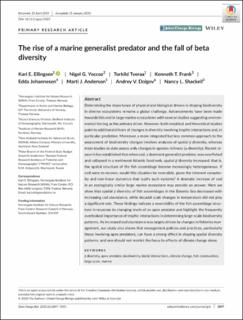| dc.contributor.author | Ellingsen, Kari | |
| dc.contributor.author | Yoccoz, Nigel | |
| dc.contributor.author | Tveraa, Torkild | |
| dc.contributor.author | Frank, Kenneth T. | |
| dc.contributor.author | Johannesen, Edda | |
| dc.contributor.author | Anderson, Marti J. | |
| dc.contributor.author | Dolgov, Andrey V. | |
| dc.contributor.author | Shackell, Nancy L. | |
| dc.date.accessioned | 2020-10-21T13:04:36Z | |
| dc.date.available | 2020-10-21T13:04:36Z | |
| dc.date.created | 2020-03-18T15:04:02Z | |
| dc.date.issued | 2020 | |
| dc.identifier.citation | Global Change Biology. 2020, 26 (5), 2897-2907. | en_US |
| dc.identifier.issn | 1354-1013 | |
| dc.identifier.uri | https://hdl.handle.net/11250/2684241 | |
| dc.description.abstract | Determining the importance of physical and biological drivers in shaping biodiversity in diverse ecosystems remains a global challenge. Advancements have been made towards this end in large marine ecosystems with several studies suggesting environmental forcing as the primary driver. However, both empirical and theoretical studies point to additional drivers of changes in diversity involving trophic interactions and, in particular, predation. Moreover, a more integrated but less common approach to the assessment of biodiversity changes involves analyses of spatial β diversity, whereas most studies to date assess only changes in species richness (α diversity). Recent research has established that when cod, a dominant generalist predator, was overfished and collapsed in a northwest Atlantic food web, spatial β diversity increased; that is, the spatial structure of the fish assemblage became increasingly heterogeneous. If cod were to recover, would this situation be reversible, given the inherent complexity and non‐linear dynamics that typify such systems? A dramatic increase of cod in an ecologically similar large marine ecosystem may provide an answer. Here we show that spatial β diversity of fish assemblages in the Barents Sea decreased with increasing cod abundance, while decadal scale changes in temperature did not play a significant role. These findings indicate a reversibility of the fish assemblage structure in response to changing levels of an apex predator and highlight the frequently overlooked importance of trophic interactions in determining large‐scale biodiversity patterns. As increased cod abundance was largely driven by changes in fisheries management, our study also shows that management policies and practices, particularly those involving apex predators, can have a strong effect in shaping spatial diversity patterns, and one should not restrict the focus to effects of climate change alone. | en_US |
| dc.language.iso | eng | en_US |
| dc.relation.uri | https://doi.org/10.1111/gcb.15027 | |
| dc.title | The rise of a marine generalist predator and the fall of beta diversity | en_US |
| dc.type | Peer reviewed | en_US |
| dc.type | Journal article | en_US |
| dc.description.version | publishedVersion | en_US |
| dc.subject.nsi | VDP::Zoologiske og botaniske fag: 480 | en_US |
| dc.subject.nsi | VDP::Zoology and botany: 480 | en_US |
| dc.source.pagenumber | 2897-2907 | en_US |
| dc.source.volume | 26 | en_US |
| dc.source.journal | Global Change Biology | en_US |
| dc.source.issue | 5 | en_US |
| dc.identifier.doi | 10.1111/gcb.15027 | |
| dc.identifier.cristin | 1802264 | |
| dc.relation.project | Norges forskningsråd: 234359 | en_US |
| dc.relation.project | Egen institusjon: Norwegian institute for nature research | en_US |
| dc.relation.project | Andre: Framsenteret | en_US |
| cristin.ispublished | true | |
| cristin.fulltext | original | |
| cristin.qualitycode | 2 | |
